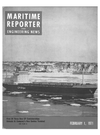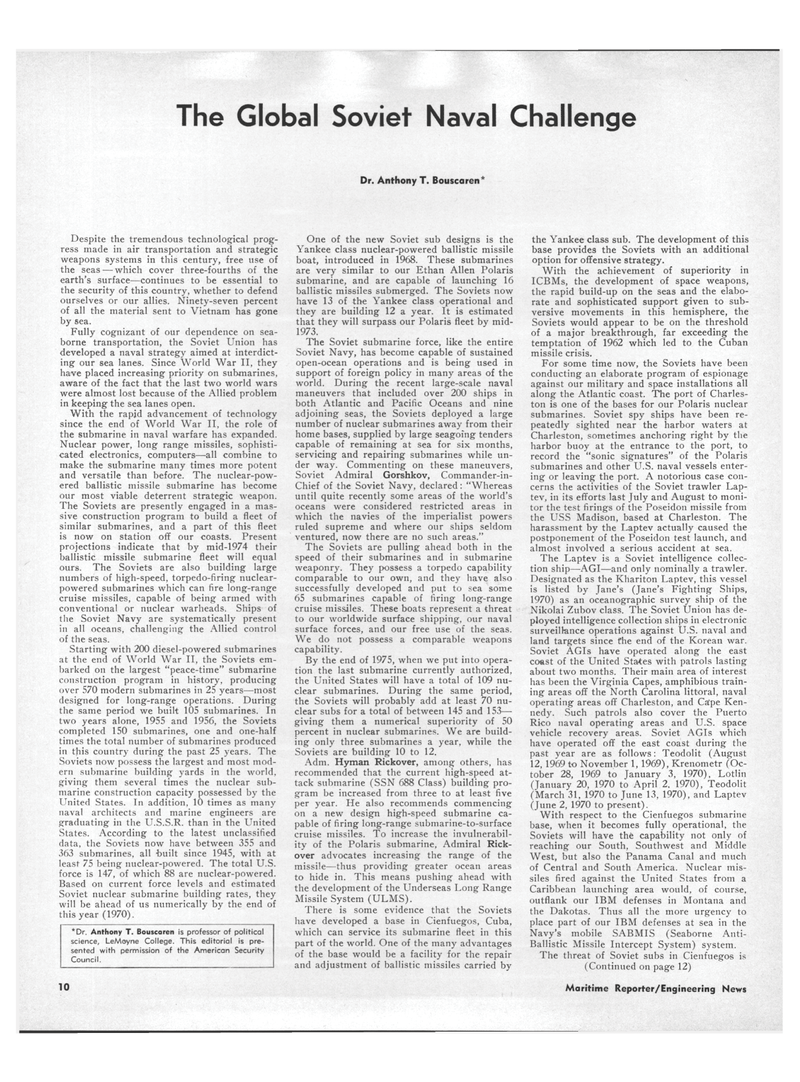
Page 8: of Maritime Reporter Magazine (February 1971)
Read this page in Pdf, Flash or Html5 edition of February 1971 Maritime Reporter Magazine
The Global Soviet Naval Challenge
Dr. Anthony T. Bouscaren*
Despite the tremendous technological prog- ress made in air transportation and strategic weapons systems in this century, free use of the seas — which cover three-fourths of the earth's surface—continues to be essential to the security of this country, whether to defend ourselves or our allies. Ninety-seven percent of all the material sent to Vietnam has gone by sea.
Fully cognizant of our dependence on sea- borne transportation, the Soviet Union has developed a naval strategy aimed at interdict- ing our sea lanes. Since World War II, they have placed increasing priority on submarines, aware of the fact that the last two world wars were almost lost because of the Allied problem in keeping the sea lanes open.
With the rapid advancement of technology since the end of World War II, the role of the submarine in naval warfare has expanded.
Nuclear power, long range missiles, sophisti- cated electronics, computers—all combine to make the submarine many times more potent and versatile than before. The nuclear-pow- ered ballistic missile submarine has become our most viable deterrent strategic weapon.
The Soviets are presently engaged in a mas- sive construction program to build a fleet of similar submarines, and a part of this fleet is now on station off our coasts. Present projections indicate that by mid-1974 their ballistic missile submarine fleet will equal ours. The Soviets are also building large numbers of high-speed, torpedo-firing nuclear- powered submarines which can fire long-range cruise missiles, capable of being armed with conventional or nuclear warheads. Ships of the Soviet Navy are systematically present in all oceans, challenging the Allied control of the seas.
Starting with 200 diesel-powered submarines at the end of World War II, the Soviets em- barked on the largest "peace-time" submarine construction program in history, producing over 570 modern submarines in 25 years—most designed for long-range operations. During the same period we built 105 submarines. In two years alone, 1955 and 1956, the Soviets completed 150 submarines, one and one-half times the total number of submarines produced in this country during the past 25 years. The
Soviets now possess the largest and most mod- ern submarine building yards in the world, giving them several times the nuclear sub- marine construction capacity possessed by the
United States. In addition, 10 times as many naval architects and marine engineers are graduating in the U.S.S.R. than in the United
States. According to the latest unclassified data, the Soviets now have between 355 and 363 submarines, all built since 1945, with at least 75 being nuclear-powered. The total U.S. force is 147, of which 88 are nuclear-powered.
Based on current force levels and estimated
Soviet nuclear submarine building rates, they will be ahead of us numerically by the end of this year (1970). *Dr. Anthony T. Bouscaren is professor of political science, LeMoyne College. This editorial is pre- sented with permission of the American Security
Council.
One of the new Soviet sub designs is the
Yankee class nuclear-powered ballistic missile boat, introduced in 1968. These submarines are very similar to our Ethan Allen Polaris submarine, and are capable of launching 16 ballistic missiles submerged. The Soviets now have 13 of the Yankee class operational and they are building 12 a year. It is estimated that they will surpass our Polaris fleet by mid- 1973.
The Soviet submarine force, like the entire
Soviet Navy, has become capable of sustained open-ocean operations and is being used in support of foreign policy in many areas of the world. During the recent large-scale naval maneuvers that included over 200 ships in both Atlantic and Pacific Oceans and nine adjoining seas, the Soviets deployed a large number of nuclear submarines away from their home bases, supplied by large seagoing tenders capable of remaining at sea for six months, servicing and repairing submarines while un- der way. Commenting on these maneuvers,
Soviet Admiral Gorshkov, Commander-in-
Chief of the Soviet Navy, declared: "Whereas until quite recently some areas of the world's oceans were considered restricted areas in which the navies of the imperialist powers ruled supreme and where our ships seldom ventured, now there are no such areas."
The Soviets are pulling ahead both in the speed of their submarines and in submarine weaponry. They possess a torpedo capability comparable to our own, and they have also successfully developed and put to sea some 65 submarines capable of firing long-range cruise missiles. These boats represent a threat to our worldwide surface shipping, our naval surface forces, and our free use of the seas.
We do not possess a comparable weapons capability.
By the end of 1975, when we put into opera- tion the last submarine currently authorized, the United States will have a total of 109 nu- clear submarines. During the same period, the Soviets will probably add at least 70 nu- clear subs for a total of between 145 and 153— giving them a numerical superiority of 50 percent in nuclear submarines. We are build- ing only three submarines a year, while the
Soviets are building 10 to 12.
Adm. Hyman Rickover, among others, has recommended that the current high-speed at- tack submarine (SSN 688 Class) building pro- gram be increased from three to at least five per year. He also recommends commencing on a new design high-speed submarine ca- pable of firing long-range submarine-to-surface cruise missiles. To increase the invulnerabil- ity of the Polaris submarine, Admiral Rick- over advocates increasing the range of the missile—thus providing greater ocean areas to hide in. This means pushing ahead with the development of the Underseas Long Range
Missile System (ULMS).
There is some evidence that the Soviets have developed a base in Cienfuegos, Cuba, which can service its submarine fleet in this part of the world. One of the many advantages of the base would be a facility for the repair and adjustment of ballistic missiles carried by the Yankee class sub. The development of this base provides the Soviets with an additional option for offensive strategy.
With the achievement of superiority in
ICBMs, the development of space weapons, the rapid build-up on the seas and the elabo- rate and sophisticated support given to sub- versive movements in this hemisphere, the
Soviets would appear to be on the threshold of a major breakthrough, far exceeding the temptation of 1962 which led to the Cuban missile crisis.
For some time now, the Soviets have been conducting an elaborate program of espionage against our military and space installations all along the Atlantic coast. The port of Charles- ton is one of the bases for our Polaris nuclear submarines. Soviet spy ships have been re- peatedly sighted near the harbor waters at
Charleston, sometimes anchoring right by the harbor buoy at the entrance to the port, to record the "sonic signatures" of the Polaris submarines and other U.S. naval vessels enter- ing or leaving the port. A notorious case con- cerns the activities of the Soviet trawler Lap- tev, in its efforts last July and August to moni- tor the test firings of the Poseidon missile from the USS Madison, based at Charleston. The harassment by the Laptev actually caused the postponement of the Poseidon test launch, and almost involved a serious accident at sea.
The Laptev is a Soviet intelligence collec- tion ship—AGI—and only nominally a trawler.
Designated as the Khariton Laptev, this vessel is listed by Jane's (Jane's Fighting Ships, 1970) as an oceanographic survey ship of the
Nikolai Zubov class. The Soviet Union has de- ployed intelligence collection ships in electronic surveillance operations against U.S. naval and land targets since fhe end of the Korean war.
Soviet AGIs have operated along the east coast of the United States with patrols lasting about two months. Their main area of interest has been the Virginia Capes, amphibious train- ing areas off the North Carolina littoral, naval operating areas off Charleston, and Ca!pe Ken- nedy. Such patrols also cover the Puerto
Rico naval operating areas and U.S. space vehicle recovery areas. Soviet AGIs which have operated off the east coast during the past year are as follows: Teodolit (August 12, 1969 to November 1, 1969), Krenometr (Oc- tober 28, 1969 to January 3, 1970), Lotlin (January 20, 1970 to April 2. 1970), Teodolit (March 31, 1970 to June 13, 1970), and Laptev (June 2, 1970 to present).
With respect to the Cienfuegos submarine base, when it becomes fully operational, the
Soviets will have the capability not only of reaching our South, Southwest and Middle
West, but also the Panama Canal and much of Central and South America. Nuclear mis- siles fired against the United States from a
Caribbean launching area would, of course, outflank our IBM defenses in Montana and the Dakotas. Thus all the more urgency to place part of our IBM defenses at sea in the
Navy's mobile SABMIS (Seaborne Anti-
Ballistic Missile Intercept System) system.
The threat of Soviet subs in Cienfuegos is (Continued on page 12) 10 Maritime Reporter/Engineering News

 7
7

 9
9
